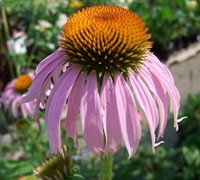

Many gardeners across the world grow them for their beauty, as well as their vivid color. These traits make them perfect for anyone who’s just getting started on their garden journey, but they aren’t just reserved for beginners. It also helps that most varieties are inexpensive. Purple coneflowers aren’t particularly fussy plants once you know what they need. Some are spindly, thin, and wiry, while others are much thicker, but they still tend to be on the narrow side. The petals themselves are vivid, ringing the center of the flower. The flowers are the real star of this plant, instantly recognizable for the eye at the center, cone-like and usually brown, but it can also feature other colors, or reflect the color of the petals. The size of the foliage ranges on the individual leaf, getting anywhere between 10 and 20cm long. You’ll be able to spot a visible center vein on each leaf. The foliage is a lovely green no matter the season, typically ovate shaped, or between ovate and lanceolate. Some varieties will bloom during the early part of summer, and only summer, while others appear later, stretching into fall if the weather allows. It grows from underground rhizomes, and blooms during the height of summer. The coneflower can range from half a foot to 4 feet tall, depending on the variety you go for, and the conditions you grow it in. This term typically refers to sea urchins, which these striking flowers also resemble in the center cone of the flower.īecause of its popularity and how easy it is to grow, it’s unsurprising that this plant is readily available and sold as seeds and adult plants alike, all across the world. The genus name, Echinacea, comes from the Greek word which means ‘spiny one’. You do get other forms of Echinacea, but the purple type, Echinacea purpurea, is by far the most popular. In the wild, you’ll find coneflowers in dry woodland, and prairies. The petals usually point toward the earth, though they may also be erect. It’s instantly recognizable for its long, daisy-like petals, and central eyes which are cone-shaped. At a Glance: What You Should Know About Purple ConeflowersĮchinacea purpurea, or the purple coneflower, is found naturally in many parts of America, as well as Ontario in Canada.


 0 kommentar(er)
0 kommentar(er)
